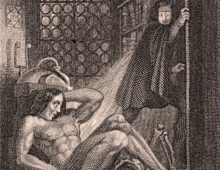Tagged with Paintings
Resource : Queen Marie Antoinette of France and two of her children walking in The Park of Trianon
Marie Antoinette was the wife of the last King of France, Louis XVI, before the French Revolution overthrew the monarchy. She was known for extravagance and indulgence, and was despised by the people of France. She came to symbolise the Ancien Régime – a long-standing system where the monarchy, aristocracy and Catholic Church held absolute power and privilege over ordinary people.
Resource : James Joule
James Joule became a world-renowned physicist, initially by seeking scientific advances to help his family brewery. He is best remembered for his discovery that different forms of energy – electrical, mechanical, heat – are interchangeable, and for establishing that energy can neither be created nor destroyed. The International unit of energy, the joule, is named in his honour.
Resource : The Battle of Vertières
In the late 1700s, the western part (St. Domingue) of the Caribbean island of Hispaniola was under French colonial rule. It had long been a major centre of sugar production on plantations using enslaved African labour. In 1791, Toussaint Louverture led the first – and only – successful uprising of slaves, in St Domingue. After a series of bloody conflicts and traumas with European colonial powers, St Domingue was renamed Haïti and became the first independent Black republic in 1804. These events became known as the Haitian revolution and played an important role in the decline of the Transatlantic slave trade. This lithograph depicts the Battle of Vertières in 1803, the final engagement between Haiti’s revolutionaries and Napoleon’s French forces.
Resource : Angelica Kauffmann
Angelica Kauffman was a successful and influential artist of the mid-late 1700s, and one of only two female founder members of the Royal Academy of Arts, in London in 1768. Despite also being a skilled portrait and landscape artist, she is remembered primarily for her success as a history painter. This was seen as the most elite category in academic painting at the time, and an unusual choice for a female artist.
Resource : Figures by Chelsea Waterworks, London, observing the fires of the Gordon Riots, 7 June 1780
The Gordon Riots were a series of anti-Catholic protests which took place in London between 2 and 9 June, 1780. The protests began peacefully but descended into chaos. Crowds paralysed the city with an unparalleled level of violence, with rioters attacking and setting fire to official buildings and people’s homes. The riots are considered by some historians as being the closest Britain has ever come to a full-scale revolution, and shocked fellow European powers.
Resource : Episodes from September Days 1830 on the Place de l’Hôtel de Ville in Brussels
This painting by Gustaf Wappers depicts the Belgian Revolution of 1830, which resulted in the independence of Belgium from the Dutch-ruled United Kingdom of the Netherlands.
Resource : Bonaparte at the Pont d’Arcole, Antoine-Jean Gros
Napoleon rose to power during the French Revolution, crowning himself Emperor of France in 1804. He had ambitions to carve out a vast empire and dynasty, and successfully invaded and conquered countries across the European continent in a series of bloody battles, before he was finally defeated at the Battle of Waterloo in 1815. These became known as the Napoleonic wars.
Resource : Sir Joshua Reynolds’ portrait of Sir Banestre Tarleton
This portrait shows the flamboyant and controversial figure Sir Banestre Tarleton, a cavalry officer best known as commander of the ‘Tarleton Raiders’ during the American war of independence. It was painted by Sir Joshua Reynolds, the leading British portrait painter of the 18th century. Reynolds was a founding member of the Royal Academy and its first President, and was knighted by King George III.
Resource : Crompton’s spinning mule
The spinning mule was invented by Samuel Crompton in 1779. It revolutionised textile production by vastly increasing the amount of cotton that could be spun at any one time. But this also meant textile manufacturers no longer needed to pay individual spinners to create spindles (wooden rods) wound with cotton thread, as just one operator could now use the machine to spin hundreds of spindles at once.
Resource : The death of Marat by Jacques-Louis David
Jacques-Louis David (1748-1825) was the best-known painter of historical scenes of his generation. He was a strong supporter of the French Republic and effectively became its official artist. His painting, The Death of Marat, is one of the great propagandist images of the French Revolution.


